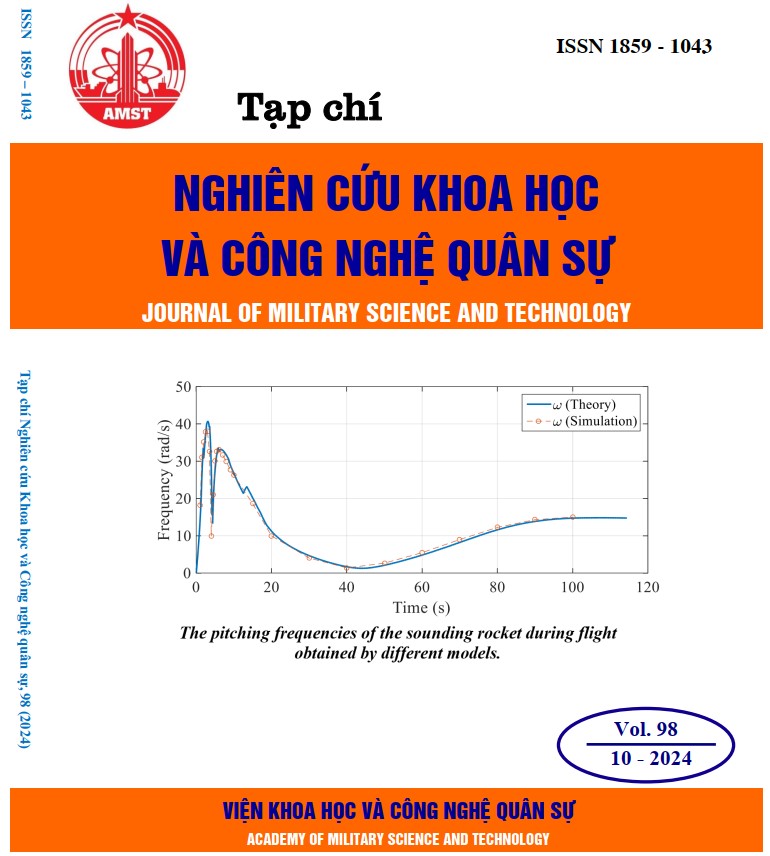A new algorithm for recognizing and estimating radar signal parameters
295 viewsDOI:
https://doi.org/10.54939/1859-1043.j.mst.98.2024.23-31Keywords:
Radar signal; Image processing; Pulse width; Carrier frequency.Abstract
This paper proposes a new algorithm based on image processing to recognize and estimate radar signal parameters such as carrier frequency, pulse width and modulation. The algorithm includes three steps. In the first step, banking filters are used for detecting and estimating signal carrier frequency. Time-frequency analysis is used in second step to extract signal feature. The last step is based on image processing for estimating pulse width and signal modulation. The simulated signals in MATLAB is used to evaluate performace of algorithm. Simulation results show that the proposed method is able to recognize and estimate parameter of single and multi-component signals.
References
[1]. N. Levanon and E. Mozeson, “Radar signals,” John Wiley & Sons, Inc., Hoboken, New Jersey,
ISBN: 0-471-47378-2, (2004).
[2]. Frigo, M., and S. G. Johnson, “FFTW: An Adaptive Software Architecture for the FFT,” Proceedings of the International Conference on Acoustics, Speech, and Signal Processing. Vol. 3,
pp. 1381-1384, (1998).
[3]. Mitra and K. Sanjit, “Digial signal processing: a computer-based approach,” 2nd Ed, New York: MacGraw-Hill, ISBN: 13 9978-0072321050, (2001).
[4]. M. Stephane, “A Wavelet tour of signal processing,” 2nd Ed, San Diego, CA: Academic Press. ISBN: 0080520839, (1999).
[5]. Lilly and Jonathan M, “Element Analysis: A Wavelet-Based Method for Analysing Time-Localized Events in Noisy Time Series,” Proceedings of the Royal Society A: Mathematical, Physical and Engineering Sciences 473, no. 2200: 20160776, (2017). https://doi.org/10.1098/rspa.2016.0776. DOI: https://doi.org/10.1098/rspa.2016.0776
[6]. S. Kiranyaz, T. Ince, O. Abdeljaber, O. Avci and M. Gabbouj, "1-D Convolutional Neural Networks for Signal Processing Applications," ICASSP 2019 - 2019 IEEE International Conference on Acoustics, Speech and Signal Processing (ICASSP), Brighton, UK, pp. 8360-8364, (2019),
doi: 10.1109/ICASSP.2019.8682194. DOI: https://doi.org/10.1109/ICASSP.2019.8682194
[7]. Z. Zhang, J. Zhang, T. Luo, T. Huang, Z. Tang, Y. Chen and D. Luo. “Radar singal intrapulse recognition based on a denoising-guided disentangled network”, Remote Sens. 14: 1252, (2022). http://doi.org/10.3390/rs14051252. DOI: https://doi.org/10.3390/rs14051252
[8]. Q. Daying, Z. Tang, X. Wang, W. Zhai, and C. Qu. "LPI Radar Signal Recognition Based on Dual-Channel CNN and Feature Fusion", Symmetry, 14, no. 3: 570, (2022). https://doi.org/10.3390/sym14030570. DOI: https://doi.org/10.3390/sym14030570
[9]. N. Otsu. "A Threshold Selection Method from Gray-Level Histograms, " IEEE Transactions on Systems, Man, and Cybernetics. Vol. 9, No. 1, pp. 62–66, (1979). DOI: https://doi.org/10.1109/TSMC.1979.4310076







